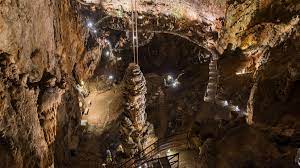Italy: Friuli region is one of Europe’s best kept secrets

Rome: Its mountains, canyons, beaches and lagoons make it one of Italy’s most beautiful and varied landscapes, but few people — and that includes Italians — know anything about it.
Perhaps because it’s tucked away on the country’s northeastern border with Slovenia and Austria, perhaps because of a history of invasions, including the Austro-Hungarian empire, or perhaps because of the many languages spoken by locals, it barely seems like part of Italy.
But although Friuli Venezia Giulia stretches from the snow-capped Alpine reaches of the Dolomites to the sun-kissed waters of the northern Adriatic sea, it never experiences the crowds that leave some parts of Italy straining in the summer.
And yet, say locals, it’s every bit as worth visiting as the rest of Italy.
“Unlike other Italian regions, we’re not advertised and are far from mass tourism,” says local tour guide Roberta Bressan. “Ours is a small-scale, niche reality travelers should discover bit by bit, made of a constellation of beautiful tiny towns and different traditions.”
One of the region’s biggest selling points is its scenery. With 13 natural reserves and the pristine park of the Friuli Dolomite Mountains, the region lures tourists seeking to connect with nature or explore the outdoors.
“It’s a green, heavenly patch. You can go biking and trekking in the Dolomites’ park and kayaking along mountain springs and rock tunnels with fluorescent blue waters,” says local travel blogger Luca Vivan.
Friuli’s verdant valleys are surrounded by Alpine peaks which, on clear days, offer views all the way down to the coast. Labyrinths of caves, ravines and canyons with waterfalls and fast-flowing rivers dot the vast karst limestone plateau at the feet of the hills.
Outdoor activities happen all year round. Warmer weather brings hang gliding flights, kayaking in turquoise clear rivers, sailing, windsurfing and rock climbing. In winter, there’s skiing and sledding in cozy resorts like Tarvisio, Tolmezzo and Piancavallo.
Geological wonders include the underwater cave of Gorgazzo lake, with its incredible tropical blue-green colors. There’s also the spellbinding Grotta Gigante, or Giant Cave, one of the world’s largest tourist caverns.
There are trekking trails that follow the rock-embedded footprints and skeletons of dinosaurs and old shepherd routes that connect sleepy hamlets.
The lagoon island-town of Grado, which resembles a miniature Venice, is as close as Friuli gets to a popular vacation resort while Lignano Sabbiadoro is one long peninsula of golden beaches.
Trieste boasts an unusual segregated beach, with origins dating back several centuries. Visitors to Bagno all Lanterna are divided into men and women, and kept apart by a white wall running up the middle of the beach.
“Residents are very fond and proud of this place,” says Trieste local Maria Bonacci. “They see it as embodying avant-garde same-sex freedom, and the beach’s popularity keeps growing even among youth.”
Trieste is a destination in its own right. Friuli’s capital is sometimes known as Italy’s Little Vienna because its Austro-Hungarian heritage is reflected in the majestic Mitteleuropean architecture and decadent fin de siècle vibe.
The city also boasts one of Europe’s largest squares, Piazza Unità D’Italia, overlooking the sea and surrounded by elegant palazzos showing off the sumptuous imperial grandeur of the past — a fading decadence, complete with historical cafes, that has long attracted artists and writers, such as Ireland’s James Joyce.
Bonacci believes what makes Friuli Venezia Giulia unique is its “dual soul.”
She says the juxtaposition of the imperial grandeur is reflected in cities such as Trieste and the rural, interior mountainous areas made of “silent secret villages where ancient traditions survive.”
Strong bora winds that sometimes buffet Trieste with gusts of up to 160 kilometers per hour also help power the Barcolana, one of the world’s largest sailing regattas, which attracts more than 2,000 boats of all sizes every October.
Friuli’s smaller towns are also worth exploring. Udine is a small-scale Venice with luxuriant gardens. Gorizia, on the border with Slovenia, is known as Italy’s Salzburg. The UNESCO-listed Cividale del Friuli has a picturesque medieval center overlooking the aquamarine Natisone River.
For fans of archeology, there’s the city of Aquileia, the ancient Roman capital of Friuli, which has an impressive basilica featuring a huge paleo-Christian floor mosaic that depicts symbolic animals and the tree of life.
Aristocratic glamor is everywhere. The region boasts an incredible array of fascinating castles and fortresses which hark to its wealthy and powerful past.
The Miramare Castle is Trieste’s jewel, built by Archduke Ferdinand Maximilian of Habsburg as a luxurious retreat in the 19th century. Perched on a promontory and surrounded by a luxuriant park it boasts a spectacular view of the Gulf of Trieste.
One stunning castle, which is also a luxury resort, is Castello di Spessa where it’s said the infamous Venetian lover Giacomo Casanova sojourned during one of his journeys and, predictably, had an affair with a maid. Today, guests can sleep in his extravagant suite.
But Friuli also has a “primeval” bucolic soul. It is dotted with tiny old hamlets where farming traditions and folklore live on.
The hamlet of Sappada is a remote German-speaking enclave and skiing resort with traditional, unusual slant-roofed wooden dwellings known as blockbau. Winters offer silent landscapes of snowy blankets.
Pesariis is an Alpine village famous for huge artisan clocks that decorate its alleys while nearby Sauris is known for its traditional beers and speck — a cured and smoked ham.
Cordovado, Toppo and Fagagna, villages with intact medieval districts and a sleepy ambiance, seem frozen in time and are part of Italy’s Most Beautiful Villages club.
The citadel-fortress of Palmanova is a Renaissance jewel of Venetian origins shaped like a nine-pointed star. Legend has it that Leonardo Da Vinci designed it as an “ideal city.”
Local guide Bressan, who offers tailored tours of the region, recommends navigating along Grado’s lagoon while lunching on regional seafood dishes, seeing Friuli’s medieval isolated rural chapels, exploring the Karst Plateau in fall “when colors are like an artist’s palette,” and visiting former mining centers, such as Cludinico, which are now open-air museums.
Friuli’s “war tours” are also quite popular, says Bressan. “I often organize day trips for passengers arriving on cruise ships in Trieste. American families long to see the places where their fathers or grandparents served during World War II, and they already know where to go and what to see.”
Friuli is one of Italy’s premium winemaking regions, with its fragrant, elegant whites and sparkling alternatives to the country’s more well-known Prosecco.
The two top vineyard areas are the Collio and the Colli Orientali del Friuli. Another estate, Ronco dei Tassi, is named after the badgers (“tassi” in Italian) that nibble on the mature grapes of the terraced sloping vines.
Friuli goes big on aperitivo culture. The Spritz, an iconic alcoholic drink introduced during Austrian rule, was originally made with white wine mixed with sparkling water. Today, Aperol or Campari and Prosecco are mixed to give it an orange hue — and it’s an Italian classic.
Great wines pair well with succulent cured meats.
The hilltop town of San Daniele is renowned for a sweetish ham that’s cured in both the Adriatic breeze and cool mountain air. The village also makes a little-known smoked trout known as the Queen of San Daniele — the ham being the king.
Other local delicacies can be sampled in the many no-frills frasche and osmize taverns, run by farmers, that serve local handmade cheeses, such as Montasio and Asino alongside a variety of cured meats.
Pitina is a strong-flavored salami made with goat, sheep and roe deer meat. “Underground” cheeses, seasoned in Karsic caves, are a top delicacy.
Classic Friuli dishes include a pork and vegetable soup called jota, handmade prune and blueberry gnocchi, ravioli stuffed with chocolate and cinnamon, and frico, a potato cake with fried Montasio cheese and onions.
Another specialty is musèt con la brovada, a cotechino pork sausage served with turnips fermented with grape marc.
There are many brodetto fish soups, including the busara, a dish of shrimp with black pepper, grated bread and tomatoes. Trieste’s speciality is sardoni in savor, a layered dish of anchovies and onions. Grado is renowned for its small, tasty boreto de baci clams.
For dessert, palacinche are sugary omelets while the putizza is a traditional roll cake made with chocolate, dried fruit and honey.





